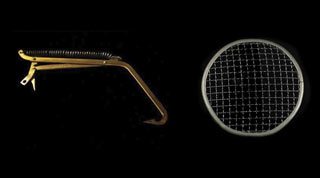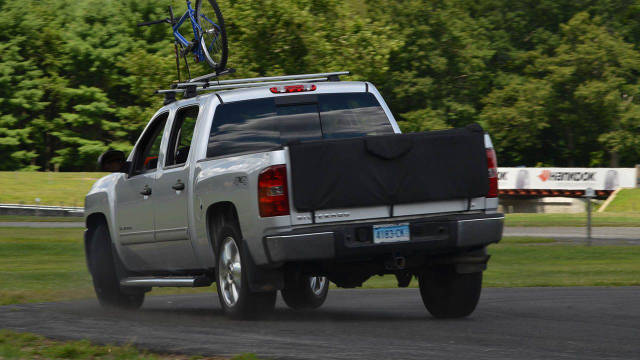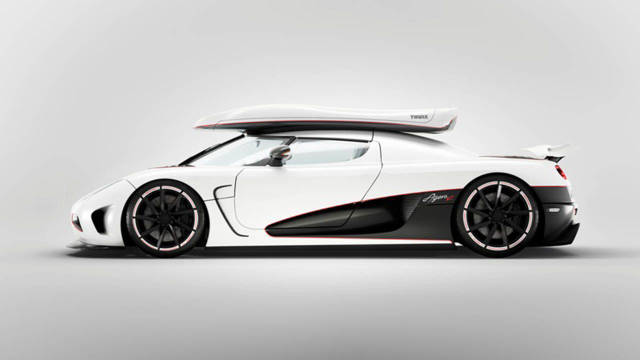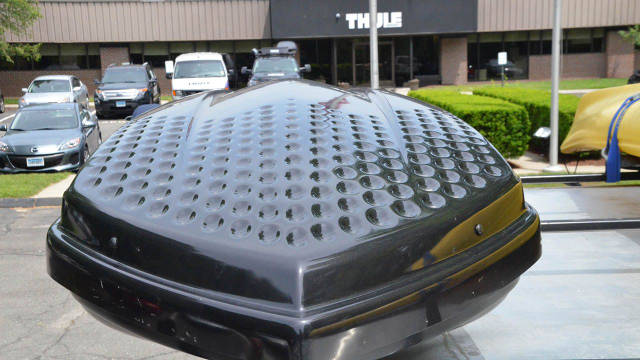By Roger Garbow August 21, 2013 / Photos by Roger Garbow News from the US
Even if you’ve never snowboarded or skied, bought a kayak or canoe, or refused to ride a bicycle, you probably know the name Thule.
Thule (pronounced “two-lee") is the world leader when it comes to rooftop transport accessories. The company's iconic aerodynamic roof boxes changed the game for ski transportation in the late ‘70s. Today, they come in a wide variety of shapes and sizes to carry much more than skis.
 Thule Headlamp Grille and Pike Trap
Thule Headlamp Grille and Pike Trap
Thule was founded in 1942 by Erik Thulin, who began making products for Swedish fishermen. It wasn't until 1955 that the company produced its first automotive accessory, a grille to protect headlamps from stone damage. Thule’s first ski rack arrived in 1962.
Today, Thule is a diverse company with worldwide manufacturing and 3400 employees. What you may not realize, however, is that more than 70 percent of the products it sells in the U.S. are actually designed, developed and manufactured in the states.
Thule employs 500 people in America, primarily in its Seymour, Connecticut and Chicago facilities. Seymour handles design, development and testing, plus most of the manufacturing. The roof boxes are made in Chicago, whose central location makes more sense for nationwide shipping of the bulky items.
 Thule tests roof racks
Thule tests roof racks
I recently toured the Connecticut facility and spent a day with the engineers testing racks at Lime Rock Park. Yup, that’s right: Thule tests its products at a race track. Thule test manager Reed Frick and test engineer Christopher Rine are the men charged with that enviable task.
At Lime Rock, engineers mounted a couple of new rooftop fork-mount bike carriers on one of Thule’s test vehicles, a Chevy Silverado 4x4 crew-cab pickup. While the carriers are rated to handle a 36-pound bike, the Thule guys push the envelope with a 55-pound dummy cycle. Its steel tubes are filled with ball bearings, and there are lead weights bolted to the frame. Then they run a slalom course to see how the carriers hold up.
Frick attacks the cones and the high-sprung Chevy exhibits predictably massive amounts of body roll, putting more strain on the bike rack than even the most aggressive consumer ever would. After multiple runs at varying speeds up to 43 mph, they head over to the autocross course. Frick does a few laps and then swaps seats with Rine, who explores both power-induced over-steer and grip-limited under-steer. The bike doesn't budge.
 Thule tests the worlds fastest roof box
Thule tests the worlds fastest roof box
Thule also tests its roof racks and roof boxes at high speed—up to 121 mph—at a secret location. Not so secret is Thule's Lightning Box project; Thule engineers developed a special carbon-fiber ski box as a £20K option for the Koenigsegg Agera R supercar. It’s integrated onto a removable roof panel and is certified for speeds up to an incredible 186 mph.
Even if you don’t have a super car in your garage, Thule's roof boxes have always been industry leaders with regard to aero efficiency and low noise levels, but the company’s newest innovation goes a step further. Taking a page from golf ball design, they arrayed the Thule Sonic Alpine with rows of aerodynamic dimples to further decrease wind drag by up to 10 percent. The Sonic Alpine isn't cheap, but it’s a bargain compared to the Lightning Box.
 Thule designs new roof box
Thule designs new roof box
Thule Group is much more than roof racks and roof boxes these days, too. Have a CaseLogic iPhone case or camera bag? That’s a Thule brand. They also own Chariot child carriers (not for the rooftop…), UWS truck-bed storage systems, and TracRac. Need more go in the snow? Thule's Easy-fit line is billed by Guinness as the “World’s Fastest Snow Chains.” One of Thule's fastest-growing product areas is its new luggage and backpack line. Chevy was so impressed, it's offering branded Thule fitted luggage for the 2014 Corvette Premiere Edition.
Back at Thule's North American headquarters in Connecticut, employees are busy making racks. Walking through the open-floorplan building, you can view the entire process as raw material is shaped, jig welded, assembled, tested and boxed for shipping. There’s even a fully equipped spare parts department that would put most car dealerships to shame. Lost the keys to your rack lock? They can ship you out a spare set.
How does Thule manage to make roof racks for practically every car on the road? Led by Nick “The Fit Viking” LeFort, Thule engineers and designers work with the car manufacturers to get measurements of the new models long before they hit the showroom. Many manufacturers don't even make their own racks anymore. They just sell Thule products through their own parts departments.
As my factory tour finished up, I remarked to Karl that while I love the newer designs and latching systems, I still use the Thule racks I purchased 20 years ago. They seem to last forever. He nodded and said he hears that all the time. That may not be good for replacement business, but it sure makes for happy and loyal customers.
http://www.youtube.com/watch?v=gutT4FSGCgM
source: roadandtrack.com
Find out how to contact us, ordering and much more
Find out more about us
Need information about a product or lost a manual
